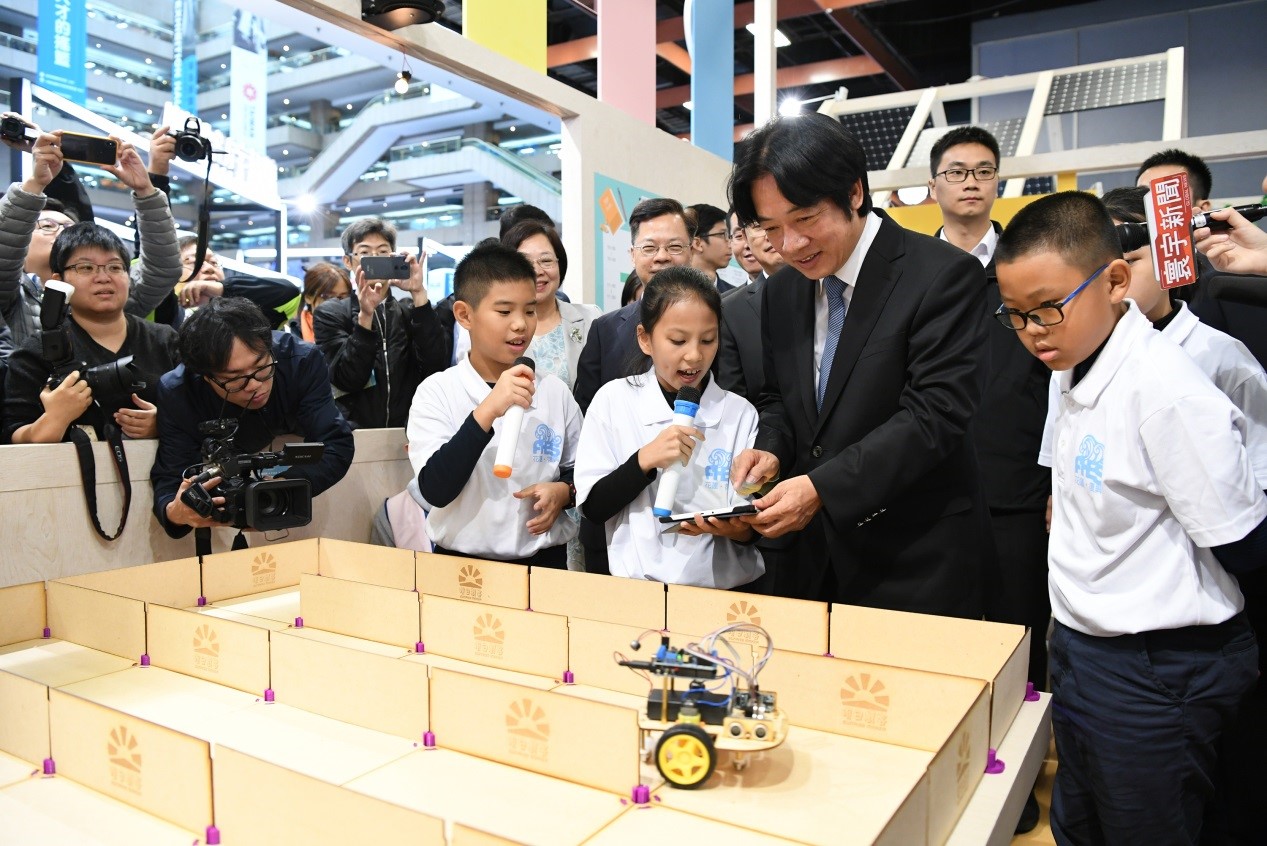“EdTech Taiwan” Exhibition during 2018 IT Month Multi-faceted Digital Education Lets all Children Shine

As part of last year’s IT Month, the Ministry of Education (MOE) participated in the EdTech Taiwan exhibition at the Taipei World Trade Center from November 28 to December 3, demonstrating innovative digital education in conjunction with several schools. The theme of the EdTech Taiwan exhibition was Cross-Disciplinary Learning & Literacy Leading into a New Era. The MOE put a rich and diverse range of digital education experiences and curriculum activities on display in four exhibition areas –1.A Creativity Fair; 2.Advocacy; 3.Computational Thinking; and 4.the Smart Learning Classroom, each presenting some of the boundless exciting possibilities for future education. The smart learning classroom, for example, interacts with schoolchildren and the highly variegated displays put on by the participating schools demonstrated how digital education is more lively and interesting, and this exhibition gave the teachers and students an opportunity to show the results of their teaching and learning to the general public.
Premier Lai Ching-Te and Deputy Minister of Education Dr. Yao Leehter attended the exhibition opening on November 28, then toured the exhibition and tried out many of the activities in the display areas outlined below.
Creativity Fair
The Creativity Fair area showcased cross-disciplinary learning, with separate sections featuring emerging technologies, specialized science and technology fields, and distinctive approaches to teaching & learning. The cross-disciplinary learning approach, often called STEAM, emphasizes integrating knowledge and skills traditionally associated with science, technology, engineering, art (including design), and mathematics. Several schools were invited by the MOE to give live demonstrations of the results of their innovative teaching and learning, and experiential programs.
Fu Chuen Primary School in Taichung City, for example, presented the work of its Young Flying Champion of Good - New Vision UAV (Unmanned Aerial Vehicle) class, in the emerging technology section. The class combines learning about flight technology, maker education (this refers to hands-on collaborative project-based learning), electro-mechanics, and writing simple programs to control the UAV, to enable the teachers and students to get a good understanding of flight principles and drone operation.
Tainan Municipal Haidong Elementary School presented a project called Robots and Life in the distinctive teaching & learning approaches section. The students explored specific topics related to the theme of using the power of education to bring about sustainable development, put an end to hunger and starvation, ensure clean water resources, and maintain terrestrial ecosystems. Students can use systematic thinking and technology related skills to improve their lives and tackle environmental issues, and robotics courses can help them to become more aware of their own special qualities and develop their future potential.
Advocacy
The Advocacy exhibition area showcased high-interaction resources and multimedia presentations, with separate sections on information security, internet literacy issues, and independent learning. For information security, the MOE has developed software to prevent internet use related problems to assist teachers and parents to cultivate schoolchildren’s online safety awareness and habits. This software can help prevent young schoolchildren being exposed to inappropriate information on the internet, and internet addiction. You can find details at https://nga.moe.edu.tw/web/description_pc.
“Safe and reasonable internet use” is the main goal of internet literacy. A diverse range of online teaching resources is available at http://eteacher.edu.tw that teachers and parents can use to help teenagers form correct internet use attitudes and behavior.
And for independent learning, the FUN Learning King website at https://fun.edu.tw offers more than 8,000 micro-courses that allow students to learn in a quality digital environment, anytime and anywhere. The micro-courses are five to ten minutes long and cover major subjects from elementary to senior secondary school level.
Computational Thinking
The focus in this area was on using basic computer science concepts for ways of thinking to engage in problem solving. Every field of study and every industry is increasingly reliant on information technology, and fostering thinking skills can help people analyze problems and develop problem-solving methods, and then engage in effective decision-making.
The “Unplugged Activities” in this exhibition area challenged participants’ problem-solving abilities. They included interesting problems encountered in everyday life, and some incorporated real life objects. The significant underlying information science factors were explained during the process of each activity. People could also try out programming using some of the programming games designed to let the public experience problem solving using programming. You can find details at http://compthinking.csie.ntnu.edu.tw.
The Smart Learning Classroom
In this display area, a specially constructed smart learning classroom presented a variety of digital teaching and learning situations, and this provided an excellent opportunity to promote the Forward-Looking Infrastructure Plan. This is a project to build up the essential infrastructure environment to support digital learning and teaching. The smart learning classroom display included talks and demonstrations of how to use such classrooms effectively to ensure that students and teachers alike get the very most out of classroom experiences.
Photo:Students from Fu-Shin Primary School in Hualian County showing their Programming Education display to Premier Lai Ching-Te on November 28.
